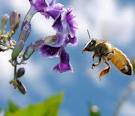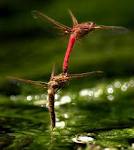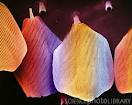Types of Flying Insects
Of the 29 orders of
insects in the world, 25 are flighted.
Each of the 25 orders has its own unique aerial capabilities and
challenges.
Some of the more common and interesting orders are briefly
discussed here.
Coleoptera (beetles):
Beetles have only one set of wings used in aerial flight.
The outer set, known as elytera, are hard and serve as a
protective cover for the inner set. Because this outer set
must be held open during flight beetles are often clumsy fliers.

Stag beetle in flight with dark elytra held above flight capable
wings
http://maria.fremlin.de/stagbeetles/andras/flying_aa.html
Hymenoptera (wasps and bees):
Members of the order hymenoptera have two sets of wings used in
flight and are often very hardy fliers. One example is the
domestic honey bee (Apis
meliferous) which flies great distances in search of
food. Some challenges faced by this order are an inability
to hover and fly in rain.

Honeybee about to land on flowering plant
http://www.vivaboo.com/pollination-done-time-for-lift-off/
Odonata (dragonflies and
damselflies): Because of their lifestyle of
feeding on other flying insects, odonates have evolved to be the
MOST aerial of flying insects. Their aerial capabilities
come from the fact that they can move each of their four wings
independently of each other. Both dragonflies and
damselflies mate in the air. Human pilots and engineers have
tried for years to develop toys and planes which mimic these
insects' maneuverability. Thus far, developing these
calculations has proven too complex.

Mating dragonflies
www.people.vcu.edu/~gadelhak/vita.htm
Thysanoptera (thrips or air-swimmers): These
little-known insects are so small that the air around them acts
like a fluid allowing them to "swim" rather then fly through the
air. This ability is increased by the presence of four small
feathered wings. In rare cases small members of the order
hymenoptera have developed similar capabilities.

Thrips with wings
spread
http://home.comcast.net/~pholowko/OnLineShows/Soil/MicroBio/ControlingPestsByPests.html
Diptera (flies):
Perhaps the most well known of all flying insects, the diptera,
only have one set of wings with the second set being reduced to
tiny air sacs known as halters. These halters are believed
to be involved in in-flight balance and allow flies to do
incredible aerodynamic moves such as hovering and mid-air mating
dances (robber flies).

Image showing halters (at end of black lines)
http://www.insectsofwestvirginia.net/f/glossary.html
Lepidoptera
(butterflies): Butterflies are perhaps the most
challenged of flying insects due to the heavy scales that cover
their wings. Although heavy and costly to overall energy
conservation these scales provide butterflies with many benefits,
such as escaping spider webs and the ability to develop bright
"warning" coloration.


Blown
up image of butterfly wing scales
Blown
up image of butterfly wing scale patterns
www.sciencephoto.com/media/371723/enlarge
http://www.absoluteastronomy.com/topics/Scale_(zoology)






